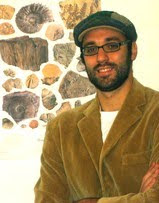 Ray Troll is one of my favorite paleo-artists, thanks to his very peculiar style. Colorful vivid, ironic, dreamy: Troll's artworks have a unique, unmistakable appeal. Recently, Troll and Kirk Johnson organized an exhibit with a weird name: Cruisin' the Fossil Freeway. It makes no surprise that I decided to investigate.
Ray Troll is one of my favorite paleo-artists, thanks to his very peculiar style. Colorful vivid, ironic, dreamy: Troll's artworks have a unique, unmistakable appeal. Recently, Troll and Kirk Johnson organized an exhibit with a weird name: Cruisin' the Fossil Freeway. It makes no surprise that I decided to investigate.I discovered that 'Cruisin' the Fossil Freeway' was presented at the Burke Museum, displaying a sort of paleo-road trip through American West. What an engaging theme! Unfortunately, I live in Europe, so it is quite difficult to visit the show. What a pity!
A look at artist Ray Troll's artistic process throughout the creation of the Cruisin' the Fossil Freeway exhibit, on view at the Burke Museum of Natural History and Culture.
Nevertheless, I found a possibility. Ray Troll and Kirk Johnson authored a book with the same name: it is 'Cruisin' the Fossil Freeway: An Epoch Tale of Scientist and an Artist on the Ultimate 5,000-Mile Paleo Road Trip'. It follows the travels of a paleontologist and an artist driving across the American West in search of fossils. The book is filled with Troll's art! Although only this makes the book a must-have, there is much more. 'Cruisin' the Fossil Freeway' is not a coffee-table book, it is a sort of illustrated diary. The story is presented with a very engaging narrative, full of anectodes and curious facts. It's a pleasure to read it!
'Cruisin' the fossil Freeway' recalls the spontaneous road trips of Kerouac and his friends across mid-century America. More in detail, I thought of Kerouac's 'On the Road' when I read of a 'paleontologic' backstage with Ziggy Marley!
Kirk Johnson, PhD, chief curator at the Denver Museum of Nature & Science talks about his award-winning book, Cruisin' the Fossil Freeway.
Curiosities apart, the book is an amazing road-trip travelogue with an impressive visual part, including not only Troll's illustrations but also many 'on the road' photographs.
If you like adventure, fossils or art, then you will enjoy this book!
Ray Troll authored also a paleontologic song: this is the 'Devonian Blues'! If you liked the music, you can't miss Troll's 'Cannery Girl'!













